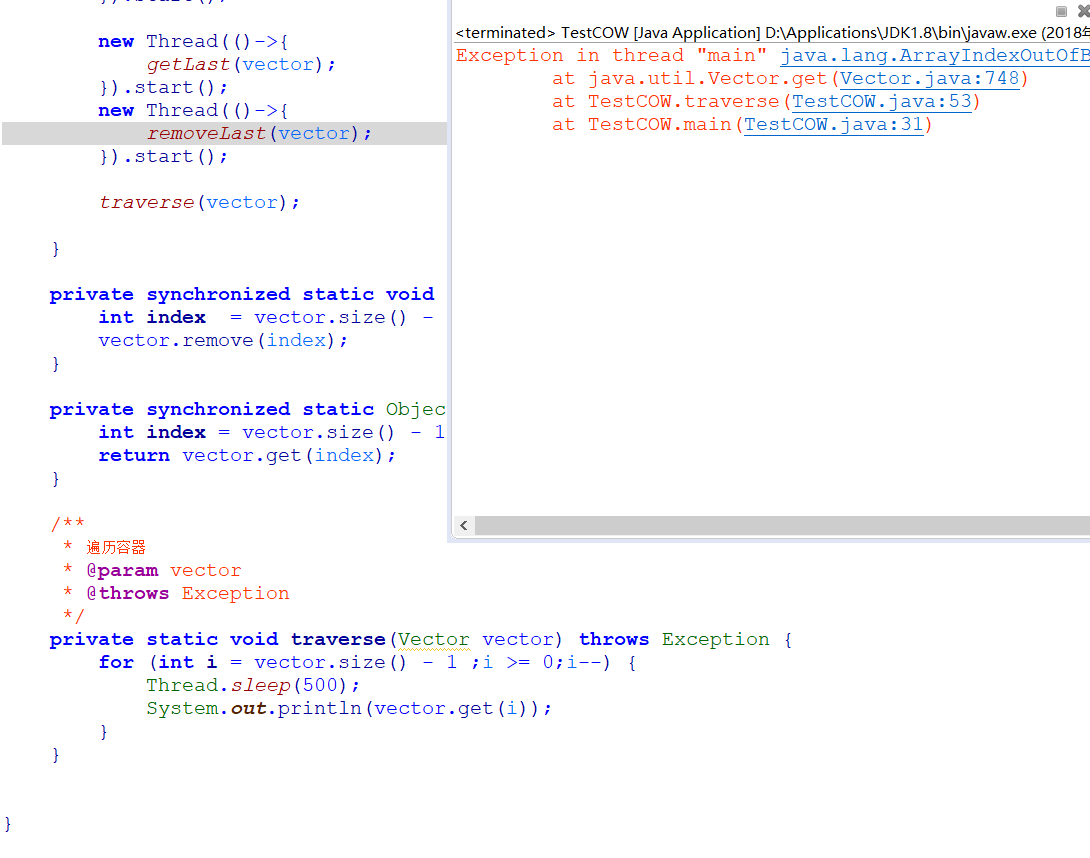List的并发容器-CopyOnWriteList
Vector和SynchronizedList
ArrayList是用来代替Vector,Vector是线程安全的容器,因为它在方法上都加上了synchronized同步关键字
例如:
public synchronized void copyInto(Object[] anArray) {
System.arraycopy(elementData, 0, anArray, 0, elementCount);
}
/**
* Trims the capacity of this vector to be the vector's current
* size. If the capacity of this vector is larger than its current
* size, then the capacity is changed to equal the size by replacing
* its internal data array, kept in the field {@code elementData},
* with a smaller one. An application can use this operation to
* minimize the storage of a vector.
*/
public synchronized void trimToSize() {
modCount++;
int oldCapacity = elementData.length;
if (elementCount < oldCapacity) {
elementData = Arrays.copyOf(elementData, elementCount);
}
}
而Collections.synchronizedList方法也是在方法内部加了synchronized关键字

问题
public static void main(String[] args) {
Vector vector = new Vector();
vector.add("a");
vector.add("b");
vector.add("c");
new Thread(()->{
getLast(vector);
}).start();
new Thread(()->{
removeLast(vector);
}).start();
new Thread(()->{
getLast(vector);
}).start();
new Thread(()->{
removeLast(vector);
}).start();
}
private static void removeLast(Vector vector) {
int index = vector.size() - 1;
vector.remove(index);
}
private static Object getLast(Vector vector) {
int index = vector.size() - 1;
return vector.get(index);
}
以上这样的代码可能会发生异常,线程在交替执行的时候,我们自己方法getLast和removeLast没有保证原子性
要解决以上问题也很简单,就是在我们自己写的方法中做同步处理,例如添加synchronized关键字,想下面示例这样:
private synchronized static void removeLast(Vector vector) {
int index = vector.size() - 1;
vector.remove(index);
}
private synchronized static Object getLast(Vector vector) {
int index = vector.size() - 1;
return vector.get(index);
}
再看遍历Vector集合的时候

例如,遍历获取vector.size()为3,当其他线程对容器做了修改后,此时容器的size为2,遍历获取get(3)就会出现异常
如果使用for-each(迭代器)来做上面的操作,会抛出ConcurrentModificationException异常

要解决这个问题,也是在遍历方法对vector加锁
CopyOnWriteList
一般来说,我们会认为:CopyOnWriteArrayList是同步List的替代品,CopyOnWriteArraySet是同步Set的替代品
无论是Hashtable到ConcurrentHashMap,Vector到CopyOnWriteArrayList。
JUC下支持并发的容器与老一代的线程安全类相比,都是在做锁粒度的优化
实现
什么是COW
如果有多个调用者(callers)同时请求相同资源(如内存或磁盘上的数据存储),他们会共同获取相同的指针指向相同的资源,
直到某个调用者试图修改资源的内容时,系统才会真正复制一份专用副本(private copy)给该调用者,
而其他调用者所见到的最初的资源仍然保持不变。
优点是如果调用者没有修改该资源,就不会有副本(private copy)被建立,因此多个调用者只是读取操作时可以共享同一份资源。
看看CopyOnWriteArrayList中的数据结构
/** The lock protecting all mutators */
final transient ReentrantLock lock = new ReentrantLock();
/** The array, accessed only via getArray/setArray. */
private transient volatile Object[] array;
/**
* Gets the array. Non-private so as to also be accessible
* from CopyOnWriteArraySet class.
*/
final Object[] getArray() {
return array;
}
/**
* Sets the array.
*/
final void setArray(Object[] a) {
array = a;
}
数据结构比起ConcurrentHashMap来说很简单,使用Lock来上锁(修改数据的时候),使用Object数组来保持数据
CopyOnWriteArrayList的特点
- CopyOnWriteArrayList是线程安全容器(相对于ArrayList),底层通过复制数组的方式来实现。
- CopyOnWriteArrayList在遍历的使用不会抛出ConcurrentModificationException异常,并且遍历的时候就不用额外加锁
- 元素可以为null
揭秘
CopyOnWriteList如果做到并发环境下遍历容器而不发生异常呢?
接下来我们看看iterator方法,该方法返回的是COWIterator类。我们可以看看这个类是怎么组成的
static final class COWIterator<E> implements ListIterator<E> {
/** Snapshot of the array */
private final Object[] snapshot;
/** Index of element to be returned by subsequent call to next. */
private int cursor;
private COWIterator(Object[] elements, int initialCursor) {
cursor = initialCursor;
snapshot = elements;
}
public boolean hasNext() {
return cursor < snapshot.length;
}
public boolean hasPrevious() {
return cursor > 0;
}
@SuppressWarnings("unchecked")
public E next() {
if (! hasNext())
throw new NoSuchElementException();
return (E) snapshot[cursor++];
}
@SuppressWarnings("unchecked")
public E previous() {
if (! hasPrevious())
throw new NoSuchElementException();
return (E) snapshot[--cursor];
}
public int nextIndex() {
return cursor;
}
public int previousIndex() {
return cursor-1;
}
/**
* Not supported. Always throws UnsupportedOperationException.
* @throws UnsupportedOperationException always; {@code remove}
* is not supported by this iterator.
*/
public void remove() {
throw new UnsupportedOperationException();
}
/**
* Not supported. Always throws UnsupportedOperationException.
* @throws UnsupportedOperationException always; {@code set}
* is not supported by this iterator.
*/
public void set(E e) {
throw new UnsupportedOperationException();
}
/**
* Not supported. Always throws UnsupportedOperationException.
* @throws UnsupportedOperationException always; {@code add}
* is not supported by this iterator.
*/
public void add(E e) {
throw new UnsupportedOperationException();
}
@Override
public void forEachRemaining(Consumer<? super E> action) {
Objects.requireNonNull(action);
Object[] elements = snapshot;
final int size = elements.length;
for (int i = cursor; i < size; i++) {
@SuppressWarnings("unchecked") E e = (E) elements[i];
action.accept(e);
}
cursor = size;
}
}
可以看到类中有一个 Object[] snapshot这样的数组,根据代码可以直到这个数组保持的是待遍历的数组,对应的的就是CopyOnWriteArrayList中
保存数据的数组
由上我们可以知道,迭代器中保存的是获取CopyOnWriteList集合迭代器时的数据。所以在迭代过程中修改原来集合的数据不会影响到迭代器的遍历,所以CopyOnWriteList不能保证数据的实时一致性。